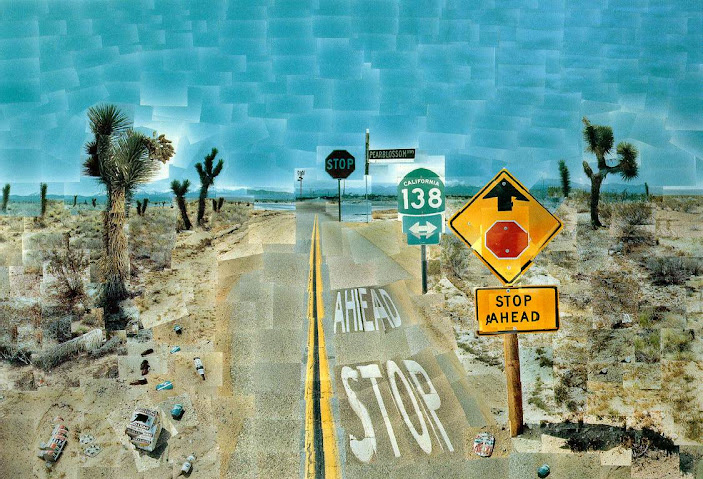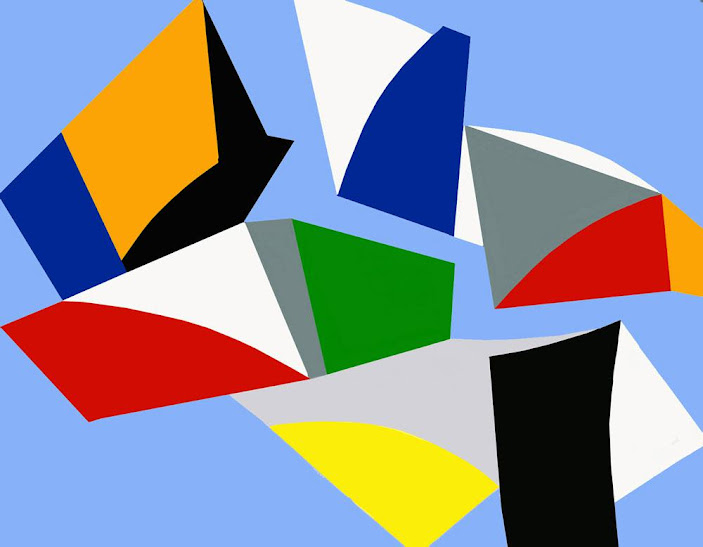
La vida y obra del pinto americano Ad Reinhardt. A continuación una reseña como sus pinturas abstractas y su infuencia sobre el minimalismo
American painter and writer. He was renowned for his work as an abstract painter and for his influence on Minimalism; he also wrote and lectured throughout his life, using these forms to deal with matters he felt were best left out of painting. He set his date of birth in the context of a personal, cultural and political chronology, describing it as having taken place nine months after the Armory Show had ended, on the eve of Europe’s entry into World War I and during the year in which Kazimir Malevich painted the first geometric abstract painting. Extensive travel throughout the world fed his encyclopedic interests.
Reinhardt studied (1931–5) literature and then art history under Meyer Schapiro (b 1904) at Columbia University, New York, where he gained a broad-based arts education; also under Schapiro’s influence he became involved in what were then considered radical campus politics. Reinhardt was editor of the humorous campus publication Jester, for which he created covers in a flattened Cubist style.
Reinhardt’s decision to be an artist was strengthened by his years at Columbia, but his practical training as a painter came primarily after graduation, first at the National Academy of Design and, from 1936 to 1937, at the American Artists’ School on 14th Street. There he was affected by the alternatives proposed by the painters who ran the school, Francis Criss (b 1901) and Carl Holty (1900–73), to the then dominant Social Realism: Criss favoured asymmetrical geometry in his urban landscapes; Holty flattened and divided figures and objects into complex and broad shapes of solid colour. Reinhardt became a member in 1937 of the American Abstract Artists (AAA), of which Holty was chairman; Reinhardt also became affiliated to the Artists’ Union and the American Artists’ Congress, through both of which he met Stuart Davis, who became a great inspiration to him. Reinhardt thus allied himself with the forward-thinking American artistic–political groups of the late 1930s.
From 1936 to 1941 Reinhardt was among the relatively few abstract artists employed in the Easel Division of the Works Progress Administration’s Federal Art Project (WPA/FAP). His numerous paintings that resulted consisted of collage-based, solid-toned, linear, interlocking, geometric forms, such as Abstract Painting (1940; priv. col., see Lippard, 1981, pl. 20) in which his circular and rectilinear shapes were composed as variations on small, cut-paper collages. Reinhardt seemed to have reached immediate artistic maturity. During the early 1940s his original Cubist-derived geometry grew in complexity, as organic and gestural markings gradually replaced precise, hard-edged forms. Though the foundation of his art was collage, as the decade progressed his paintings and drawings were characterized by an embellished linear activity comparable to the incipient Abstract Expressionism of some of his colleagues, as in Number 18 (1949; New York, Whitney). Reinhardt’s work was included in The Ideographic Picture, the group exhibition organized in 1947 by Barnett Newman at the Betty Parsons Gallery in New York; among others taking part were Newman himself, Hans Hofmann and Theodoros Stamos. Apart from a year’s interruption for military service from 1944 to 1945, throughout the 1940s Reinhardt’s art focused progressively on a gestural and linear abstraction related to Abstract Expressionism.
When Reinhardt’s funding from the WPA/FAP came to an end in 1941 he began a period of commercial and industrial jobs and freelance graphic work. He was associated with the vanguard PM newspaper as an artist–reporter from 1942 to 1947, producing memorably incisive cartoons. His earliest solo shows occurred in 1943 and 1944 and recognition quickly followed. In 1944 his work was first acquired by a public collection, A. E. Gallatin’s Museum of Living Art (this collection was donated to the Philadelphia Museum of Art in 1946). Reinhardt joined the Betty Parsons Gallery in 1946, where he remained throughout his life. In 1947 he took up a post at Brooklyn College, teaching art history.
There are definite links between Reinhardt’s work and that of the Abstract Expressionists, particularly with Barnett Newman and Mark Rothko. Reinhardt’s abhorrence, however, of the biomorphism, emotionalism and cult of individuality favoured by the Abstract Expressionists led him to produce geometric paintings dominated by grid structures and by variations of a single colour, for example Red Painting (1952; New York, Met.) and Black painting (1952–3; see Colour interaction, colour pl. VIIId), signalling a break with them. Curved forms were eliminated in favour of horizontal and vertical brick-like strokes of paint. Ragged, sinuous edges were purged. His new perception of the work of Piet Mondrian and his personal contact with Josef Albers, with whom he taught in the Yale University Art Department from 1952 to 1953, were catalysts for this return to the geometric. The solid symmetrical blocks of colours characteristic of his late paintings appeared by 1952. These rectilinearly and then squarely structured monochrome paintings were first painted in shades of blue or red and culminated in Reinhardt’s final black series, for example Abstract Painting, Black (1960–66; London, Tate). With these ‘ultimate’ paintings, Reinhardt merged his art and his aesthetics, concentrating the viewer’s attention on gradations of colour of such subtlety that they were nearly impossible to see. Reinhardt’s early identification with the New York School was challenged by his more potent role as the precursor of Minimalism and conceptual art of the 1960s and 1970s. His reductive paintings, buttressed by some of his most complex prose, insisted on the primacy of direct observation unattended by literary or naturalistic association. These dark and seemingly invisible works were composed in nine-part, Greek cross blocks. Reinhardt pursued this form exclusively until his death.
Patterson Sims . From Grove Art Online
Fuente: http://www.moma.org/collection/artist.php?artist_id=4856
American painter and writer. He was renowned for his work as an abstract painter and for his influence on Minimalism; he also wrote and lectured throughout his life, using these forms to deal with matters he felt were best left out of painting. He set his date of birth in the context of a personal, cultural and political chronology, describing it as having taken place nine months after the Armory Show had ended, on the eve of Europe’s entry into World War I and during the year in which Kazimir Malevich painted the first geometric abstract painting. Extensive travel throughout the world fed his encyclopedic interests.
Reinhardt studied (1931–5) literature and then art history under Meyer Schapiro (b 1904) at Columbia University, New York, where he gained a broad-based arts education; also under Schapiro’s influence he became involved in what were then considered radical campus politics. Reinhardt was editor of the humorous campus publication Jester, for which he created covers in a flattened Cubist style.
Reinhardt’s decision to be an artist was strengthened by his years at Columbia, but his practical training as a painter came primarily after graduation, first at the National Academy of Design and, from 1936 to 1937, at the American Artists’ School on 14th Street. There he was affected by the alternatives proposed by the painters who ran the school, Francis Criss (b 1901) and Carl Holty (1900–73), to the then dominant Social Realism: Criss favoured asymmetrical geometry in his urban landscapes; Holty flattened and divided figures and objects into complex and broad shapes of solid colour. Reinhardt became a member in 1937 of the American Abstract Artists (AAA), of which Holty was chairman; Reinhardt also became affiliated to the Artists’ Union and the American Artists’ Congress, through both of which he met Stuart Davis, who became a great inspiration to him. Reinhardt thus allied himself with the forward-thinking American artistic–political groups of the late 1930s.
From 1936 to 1941 Reinhardt was among the relatively few abstract artists employed in the Easel Division of the Works Progress Administration’s Federal Art Project (WPA/FAP). His numerous paintings that resulted consisted of collage-based, solid-toned, linear, interlocking, geometric forms, such as Abstract Painting (1940; priv. col., see Lippard, 1981, pl. 20) in which his circular and rectilinear shapes were composed as variations on small, cut-paper collages. Reinhardt seemed to have reached immediate artistic maturity. During the early 1940s his original Cubist-derived geometry grew in complexity, as organic and gestural markings gradually replaced precise, hard-edged forms. Though the foundation of his art was collage, as the decade progressed his paintings and drawings were characterized by an embellished linear activity comparable to the incipient Abstract Expressionism of some of his colleagues, as in Number 18 (1949; New York, Whitney). Reinhardt’s work was included in The Ideographic Picture, the group exhibition organized in 1947 by Barnett Newman at the Betty Parsons Gallery in New York; among others taking part were Newman himself, Hans Hofmann and Theodoros Stamos. Apart from a year’s interruption for military service from 1944 to 1945, throughout the 1940s Reinhardt’s art focused progressively on a gestural and linear abstraction related to Abstract Expressionism.
When Reinhardt’s funding from the WPA/FAP came to an end in 1941 he began a period of commercial and industrial jobs and freelance graphic work. He was associated with the vanguard PM newspaper as an artist–reporter from 1942 to 1947, producing memorably incisive cartoons. His earliest solo shows occurred in 1943 and 1944 and recognition quickly followed. In 1944 his work was first acquired by a public collection, A. E. Gallatin’s Museum of Living Art (this collection was donated to the Philadelphia Museum of Art in 1946). Reinhardt joined the Betty Parsons Gallery in 1946, where he remained throughout his life. In 1947 he took up a post at Brooklyn College, teaching art history.
There are definite links between Reinhardt’s work and that of the Abstract Expressionists, particularly with Barnett Newman and Mark Rothko. Reinhardt’s abhorrence, however, of the biomorphism, emotionalism and cult of individuality favoured by the Abstract Expressionists led him to produce geometric paintings dominated by grid structures and by variations of a single colour, for example Red Painting (1952; New York, Met.) and Black painting (1952–3; see Colour interaction, colour pl. VIIId), signalling a break with them. Curved forms were eliminated in favour of horizontal and vertical brick-like strokes of paint. Ragged, sinuous edges were purged. His new perception of the work of Piet Mondrian and his personal contact with Josef Albers, with whom he taught in the Yale University Art Department from 1952 to 1953, were catalysts for this return to the geometric. The solid symmetrical blocks of colours characteristic of his late paintings appeared by 1952. These rectilinearly and then squarely structured monochrome paintings were first painted in shades of blue or red and culminated in Reinhardt’s final black series, for example Abstract Painting, Black (1960–66; London, Tate). With these ‘ultimate’ paintings, Reinhardt merged his art and his aesthetics, concentrating the viewer’s attention on gradations of colour of such subtlety that they were nearly impossible to see. Reinhardt’s early identification with the New York School was challenged by his more potent role as the precursor of Minimalism and conceptual art of the 1960s and 1970s. His reductive paintings, buttressed by some of his most complex prose, insisted on the primacy of direct observation unattended by literary or naturalistic association. These dark and seemingly invisible works were composed in nine-part, Greek cross blocks. Reinhardt pursued this form exclusively until his death.
Patterson Sims . From Grove Art Online
Fuente: http://www.moma.org/collection/artist.php?artist_id=4856





















No hay comentarios:
Publicar un comentario